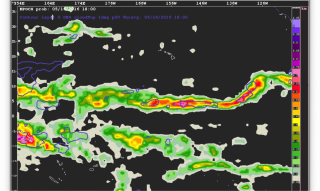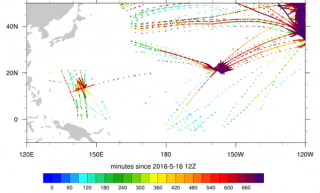Ensemble Prediction of Oceanic Convective Hazards (EPOCH)
Convective storms over oceanic regions pose a safety threat to airlines mainly due to the potential for unexpected convectively-induced turbulence which can occur above and/or adjacent to developing and existing convective storms. Because of the much longer flight times for transoceanic flights (up to 18 hours in flight), dispatchers and air traffic flow managers require forecast information spanning up to 36 hours into the future. Unfortunately, the location and timing of convective storms is very difficult to forecast especially using global scale models with grid resolutions much greater than storm scale motions that lead to convection. The goal of this project is to work with the World Area Forecast Centers (WAFC) at the Aviation Weather Center and the UK Met Office to develop methodologies for producing gridded probabilistic forecast guidance that spans this forecast time window to initially serve as a supplement to the manually generated Significant Weather Charts (SIGWX). Research toward achieving this goal involves (1) developing an accurate analysis of aviation-impacting convection and (2) developing methodologies for utilizing the wealth of global model ensemble data that has become increasingly available from multiple modeling centers to produce reliable probabilistic forecasts of aviation-impacting convection.
HIGHLIGHTS
A prototype ensemble post-processing system called EPOCH has been developed at NCAR/RAL to support research and development efforts aimed at generating global-scale probabilistic forecasts of aviation-impacting convection that optimally combines forecast information from multiple global ensemble models. The present version of the system dynamically calibrates global model ensemble data (currently using data from NCEP GEFS and the Canadian CMCE) and then combines the resulting calibrated probabilistic forecasts into a single probabilistic forecast using a linear combination. The present system generates 6-36 hour forecasts of the probability of convection and the probability of convective cloud tops exceeding a given flight level. Forecasts are issued four times per day and calibration takes place once per day using the last 21 days of observations.
The figure shows a 36-hour forecast depicting the probability of convection over the equatorial Pacific valid at 18:00 UTC on 16 May 2016. The verifying convective cloud top heights exceeding 30 kFT are depicted using purple contours. This particular example shows that regions of higher forecast probabilities just north of the equator and east of 160W are more highly correlated with cloud top height exceeding 30 kFT than the lower probabilities found to the west. Indeed, air traffic flow was mostly channeled across the equator between 175E and 160W where forecast probabilities were lower and observations of 30 kFT or higher convective activity was limited.
A critical aspect of this project is the development of a truth field that is indicative of aviation impacting convection. The project leverages previous work that resulted in the Convective Diagnostic Oceanic (CDO) product (see Oceanic/Remote Weather). CDO combines a number of satellite indicators and lightning data to characterize convective hazards. This truth field will be used to tune the model ensemble data such that it better represents a true hazard to transoceanic air traffic.
ONGOING RESEARCH
Research and development efforts are focused on improving methods for calibration of data from ensemble models and for combining information from multiple global ensembles while maximizing performance in terms of sharpness, reliability, and resolution of the final forecast product.

Calibration methods that have been considered include logistic regression, and minimization of the relative frequency unconditional bias. The performance of the ensemble forecasts and thus the combined probabilistic forecasts varies by season and region. Adaptive techniques that perform regional calibration and weighting, depending on time of year, are currently being assessed.
The figure shows the improvement in forecast performance (reliability and resolution, components of the Brier Score) as more ensembles are added to the forecast. A challenging aspect remains in terms of maintaining the sharpness of the forecast while ensuring calibration.
It is expected that new capabilities and products will be episodically demonstrated to select users as technologies mature.
REAL-TIME DISPLAY
The EPOCH products are not publically available at this time. The NWS Aviation Weather Center receives our products in real time for aviation meteorologist to evaluate the EPOCH products in AWIPS as part of their tasking to produce world area forecasts.

